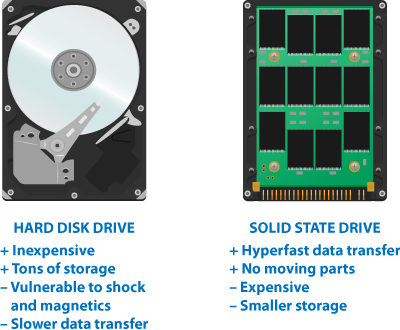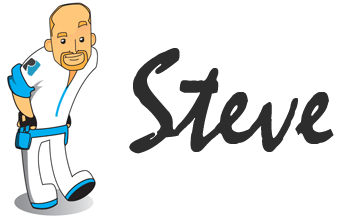-
-
products
-
resources
-
support
-
company
-
What type of Hard Drive do I Need?
By Steve Horton February 02, 2011drives, hard, hard drives, solid, solid state, stateNo Comments
Welcome to a series of articles about your PC and why it might not be running as swiftly as you’d like. Even the newest PC, especially an all-in-one model like a Dell or an HP, can have what are called bottlenecks, named for the narrow neck of a bottle. These key areas of your computer are the most susceptible to causing performance problems and we feel that you should be made aware of them and how to prevent them from slowing down you PC. These articles will help you for when you are buying a new computer and when you are optimizing one that you already own.
Today’s Question: What type of Hard Drive do I need?

So what Type of Hard Drive do I need?
Some out-of-the-box PCs, even recent ones, may try to save money by selling you an inferior, substandard hard drive. Pay attention to the following factors to know whether you’ve got something that can handle everything you throw at it.1. Solid state versus hard drives
Solid state technology is a more recent development in computer mass storage. This form of storage eliminates the platter, spindle and head that have been a part of hard drives for many years. This increases reliability and decreases the risk of crashing. The tradeoff is that solid-state technology is still very expensive per gigabyte compared to the traditional corresponding hard drive.Solid state drives are most often represented as USB thumb drives, but this isn’t always the case: many netbooks, high end laptops, Apple computers, mobile phones and tablets use 2 GB or more of solid state storage. Only the earliest iPods had traditional hard drives squeezed into them; these devices have been using solid state for years.
If you can afford it, solid state is definitely the way to go, especially if you do a lot of traveling, because these drives have no moving parts that are usually susceptible to damage from dropping or knocking. A traditional hard drive in an airport overhead bin, or worse, the back of a moving van, is a recipe for disaster. A solid state drive weathers such storms easily. Also, hard drives are sometimes susceptible to strong magnets, while solid state drives are unaffected. There’s a reason why the space shuttle has used solid state storage for years.
Solid state drives have one other major benefit over traditional hard drives that has a direct impact on your PC’s performance, and that is the speed at which information is read from and written to the drive. Traditional hard drives need to spin in order for information to be written to or read from them. Solid state drives do not, and information can be written to or read from them instantaneously. This difference may make a noticeable impact on your PC’s performance, as files and programs will load much faster (although this speed may just expose a bottleneck elsewhere, like in your RAM or CPU).
Let’s say, though, that you want the most terabytes (TB) for the money. Hard drives are still the way to go, then, and you’re in luck: they’ve have plummeted in price in recent years. As of this writing, it’s easy to find 1.5 TB or even 2 TB for around a hundred bucks, internal or external. The biggest single drive consumers can buy is 3 GB, and that’ll run you around $150.
2. Rotations per minute (RPM) and data transfer rate
Generally, the smaller the hard drive, the higher the data transfer rate and RPM. This means reliability and speed increase for the smaller drives. The massive drives give you plenty of space, but sometimes sacrifice speed and quality to do so. Additionally, laptop drives are generally slower than their desktop counterparts, simply because the platter or disc is much tinier. Look for a hard drive with at least a 5400 RPM, but opt for a 7200 RPM drive if you can in order to get the best performance from your drive.3. Storage Connection Interface
Having a fast hard drive is one thing, but if the way it is connected to your computer uses a slower port, then that will slow everything back down again. Modern day hard drives connect to computers via Serial ATA (SATA) if internal, or External Serial ATA (e-SATA) or USB if external. SATA is the most modern and offers the biggest transfer speed. If you’re like me, though, you’ve been carrying around old hard drives through multiple generations of PCs and haven’t bothered to transfer all that data over. In that case, you’ll likely be connecting through parallel ATA (the same sort of interface that your DVD drive uses, for example) and your speed will suffer.Connecting an external drive via USB can also cause issues, especially if you’ve got a slower USB 1.0 port and not a high-speed USB 2.0 port (or 3.0). Doing things like moving large amounts of data or streaming video will cause problems over USB, hence the need for an e-SATA (or even FireWire) interface, both of which are designed to move huge amounts of data quickly (in other words, their bandwidth is much greater).
If you are buying a new PC and transfer data to external hard drives frequently, make sure your computer has a USB 2.0 (or multiple) port. If you have a little extra money to spend, opt for USB 3.0, as that is soon to become the new standard and offers much faster data transfer speeds than USB 2.0, comparable to e-SATA or FireWire.
4. Software issues
Your hard drive may still be chugging along due to software issues that are easily fixable without the need to purchase new hardware. Over time, a hard drive’s data gets fragmented into too many pieces across too much of the hard drive’s storage space. Your drive will need defragmentation, and most operating systems, including Windows, include a built-in defragmenter. In Windows 7, it’s under Start Menu -> All Programs -> Accessories -> Utilities -> System Defragmenter.5. Too little RAM
Most operating systems, when faced with a memory shortage, will set up virtual memory on remaining hard drive space. Since hard drives seek data much more slowly than RAM, this will cause all sorts of system slowness issues. Luckily, RAM has dropped in price just as much as mass storage. RAM is also designed to be user replaceable, so max out whatever your system can handle (keeping in mind that 32 bit versions of Windows can’t see more than about 3 GB for each process; we’ll be talking about that in a future column.) Until then, close unused programs and kill unnecessary system processes, and that will free up your RAM for processing the tasks that you need to at the time.RAM is also available in varying speeds. This is displayed in MHz when you buy your computer. It is very common for a computer manufacturer to advertise large amounts of RAM, but this RAM is 333 MHz or 667 MHz of RAM which is slower than the higher end speeds available. Opt for DDR 3 1066 MHz RAM if you can.
6. Age
The hard drive may be having read/write issues just because of its age. Don’t count on a drive that’s more than a few years old. It may be time to back up everything you can to a shiny new inexpensive drive, and get rid of Old Unreliable. Check your drive for errors; this is done in Windows 7 by right-clicking on the drive and going to Properties -> Tools -> Error-Checking -> Check Now. Sometimes the PC will ask you to check it on startup to fix certain errors. Regularly fixing errors on an aged drive will extend the life of the drive significantly, and will reduce the chances of you having a hard drive fail and losing everything!Conclusion
Though typical hard drive issues might require a new hard drive with a more modern interface or faster data transfer rate, coaxing life out of your old drive is just as important between paychecks. Defragmenting, avoiding virtual memory usage, and regular error checking are all important. Equally important is backup! Hard drives are fragile, so back up to external media, the cloud, or a professional backup service on a regular basis.Was this post helpful?YesNoFree Driver Updates
Update your drivers in less than 2 minutes to enjoy better PC performance - Free.
Free Driver Updates
Update your drivers in less than 2 minutes to enjoy better
PC performance - Free.
Didn't find your answer?Ask a question to our community of experts from around the world and receive an answer in no time at all.most relevant recent articles Pin It on Pinterest
